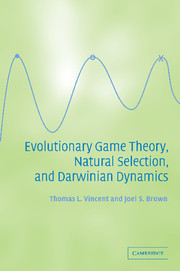Book contents
- Frontmatter
- Contents
- List of figures
- Preface
- 1 Understanding natural selection
- 2 Underlying mathematics and philosophy
- 3 The Darwinian game
- 4 G-functions for the Darwinian game
- 5 Darwinian dynamics
- 6 Evolutionarily stable strategies
- 7 The ESS maximum principle
- 8 Speciation and extinction
- 9 Matrix games
- 10 Evolutionary ecology
- 11 Managing evolving systems
- References
- Index
1 - Understanding natural selection
Published online by Cambridge University Press: 11 August 2009
- Frontmatter
- Contents
- List of figures
- Preface
- 1 Understanding natural selection
- 2 Underlying mathematics and philosophy
- 3 The Darwinian game
- 4 G-functions for the Darwinian game
- 5 Darwinian dynamics
- 6 Evolutionarily stable strategies
- 7 The ESS maximum principle
- 8 Speciation and extinction
- 9 Matrix games
- 10 Evolutionary ecology
- 11 Managing evolving systems
- References
- Index
Summary
The following observations about patterns in nature have captured the imagination of humans for millennia.
1. Fit of form and function (FF&F): different organisms appear remarkably well suited and engineered for their particular environments. The high-crowned molars of zebras and white rhinoceros act as mulching mowers for grinding grass, and protect against the inevitable wear imposed by the silica content of grass. Black rhinos, on the other hand, have lower crowned molars favoring efficient mastication of leaves and foliage. None of these animals has the sharp and stabbing canines like those of lions. Distinct species of organisms apply themselves to different ecological tasks using their appropriate sets of tools. For example, zebras and white rhinoceros feed on grass, black rhinos browse leaves from shrubs, and lions kill and eat zebras.
2. Diversity of life: we share this planet with a phenomenal array of different life forms. These forms range from delicate mosses and annual flowering plants to awesome whales and fearsome sharks. While many of these forms differ in subtle ways, most can be readily recognized and categorized as types or species quite distinct from others. This is possible because the extant denizens of our planet do not exhibit a continuum of morphological variation from bacteria to redwood tree. Rather, the morphologies and characteristics of living organisms cluster like conspicuous and discrete galaxies in morpho-space.
3. Procession of life: despite the variety and discreteness of life, organisms seem connected by design rules of increasing levels of complexity.
Information
- Type
- Chapter
- Information
- Publisher: Cambridge University PressPrint publication year: 2005
